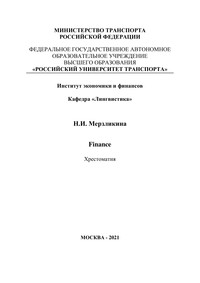Finance
Покупка
Основная коллекция
Тематика:
Английский язык
Издательство:
Российский университет транспорта
Год издания: 2021
Кол-во страниц: 49
Дополнительно
Настоящая хрестоматия предназначена для студентов-магистров специальности «Экономика». Цель хрестоматии - совершенствование умений владения профессиональным английским языком для специалистов в области финансов. Тексты хрестоматии аутентичны, профессионально ориентированы, информативны, нацелены на ознакомление обучающихся с различными сторонами деятельности экономистов.
Скопировать запись
Фрагмент текстового слоя документа размещен для индексирующих роботов
МИНИСТЕРСТВО ТРАНСПОРТА РОССИЙСКОЙ ФЕДЕРАЦИИ ФЕДЕРАЛЬНОЕ ГОСУДАРСТВЕННОЕ АВТОНОМНОЕ ОБРАЗОВАТЕЛЬНОЕ УЧРЕЖДЕНИЕ ВЫСШЕГО ОБРАЗОВАНИЯ «РОССИЙСКИЙ УНИВЕРСИТЕТ ТРАНСПОРТА» Институт экономики и финансов Кафедра «Лингвистика» Н.И. Мерзликина Finance Хрестоматия МОСКВА - 2021
МИНИСТЕРСТВО ТРАНСПОРТА РОССИЙСКОЙ ФЕДЕРАЦИИ ФЕДЕРАЛЬНОЕ ГОСУДАРСТВЕННОЕ АВТОНОМНОЕ ОБРАЗОВАТЕЛЬНОЕ УЧРЕЖДЕНИЕ ВЫСШЕГО ОБРАЗОВАНИЯ «РОССИЙСКИЙ УНИВЕРСИТЕТ ТРАНСПОРТА» Институт экономики и финансов Кафедра «Лингвистика» Н.И. Мерзликина Finance Хрестоматия для студентов-магистров специальности «Экономика» МОСКВА - 2021
УДК 42
М 52
Мерзликина
Н.И.
Finance:
Хрестоматия.
Для
студентов-магистров специальности «Экономика». – М.:
РУТ (МИИТ), 2021. – 49 с.
Настоящая
хрестоматия
предназначена
для
студентов-магистров специальности «Экономика».
Цель хрестоматии - совершенствование умений
владения профессиональным английским языком для
специалистов в области финансов. Тексты хрестоматии
аутентичны,
профессионально
ориентированы,
информативны, нацелены на ознакомление обучающихся с
различными сторонами деятельности экономистов.
©РУТ (МИИТ), 2021
Text 1. What is money and what is not money If you are trying to determine if something is money, simply consider whether it would be accepted in most stores as payment. You then realize that stocks, bonds, gold or foreign currency are not money. These must first be exchanged for the national currency before you can use them for consumption. Note that in some cases, foreign currency will be money. For example, in some border towns, the currency of the bordering country may be accepted virtually everywhere. You also realize that some bank deposits are money. If you have money in an account in a bank and a debit card, you can pay for goods and service using the card in most places. Funds are withdrawn directly from your account when you make the purchase, which makes the deposits as good as cash in your pocket. Counting deposits as money is also consistent with the idea that money measures how much is available for immediate consumption. Not all deposits can be counted as money. With most savings accounts, you cannot connect the account to a debit card and these deposits should not be counted as money. We also note that what is money has nothing to do with the commodity or token itself: USD is money in the United States but not in the U.K.; Gold is not money but gold was money in some countries in the middle ages. Historically, such diverse
commodities as cigarettes and sharks’ teeth have been used as money in some places; a national currency may suddenly cease to be money in a country. This may happen if inflation is so high that people shift to another foreign currency. Money, wealth and income Money is not the same as wealth. An individual may be very wealthy but have no money (for example by owning stocks and real estate). Another individual may have a lot of money but no wealth. This would be the case if an individual with no wealth borrows money from a bank. She will have money (for example in the form of a deposit in the bank) but no wealth since this deposit exactly matches the outstanding debt. Be careful with this distinction: do not say: “Anna has a lot of money” if you mean that Anna is wealthy. Money is not the same as income and income is not the same as wealth. Income is a flow (for example is currency units per month) while money or wealth is a stock (measured at a particular point in time). Again, it is very possible to have a high income but no money and no wealth, or to be very wealthy and have a lot of money but no income. This is another distinction to be careful with. Do not say that “Sam makes a lot of money” if you mean that Sam has a high income. Money has a very precise definition in economics! Economic functions of money Money is generally considered to have three economic functions:
A medium of exchange. This is its most important role. Without money we would live in a barter economy where we would have to trade goods and services for other goods and services. If I had fish but wanted bread, I would need to find someone who was in the precise opposite situation. In a monetary economy I can trade fish for money with one individual and money for bread with another. Money solves what is called the double coincidence of wants. A unit of account. In a monetary economy, all prices may be expressed in monetary units, which everyone may relate to. Without money, prices must be expressed in units of other goods and comparing prices are more difficult. You may find that a grilled chicken costs 2 kilos of cod in one place and 4 kilos of strawberries in another. Finding the cheapest grilled chicken is not easy. Store of value. If you are a fisherman and have a temporary surplus of fish that you want to store for the future, storing the fish might not be a great idea. Money, on the other hand, stores well. Other commodities, such as gold, have this feature as well. Text 2. What are the World’s Major Currencies? The currencies of the world’s major economies have names and backgrounds that are as diverse as the countries themselves. The dollar, used in many countries including the United States, Canada, and


